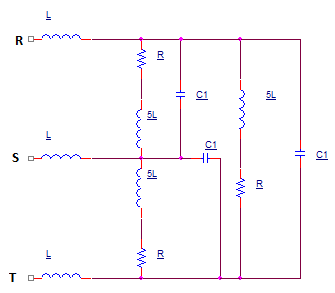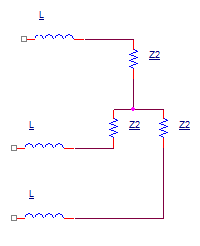I need help with the following problem:
Given symmetric three phase system (see attachment) of phase voltages with angular frequency ω=100rad/s, R=5ωL=100Ω. Find capacitance of capacitor C such that the power factor of three phase receiver has maximum value.
After transformation of Y capacitors to Δ (see attachment), it gives $$C_1=C/3.$$
Now we have a Δ connection of impedance Z which is a parallel of R,j5ωL and C1. Let $$\underline{Z_1}=R+j5\omega L.$$ From given data we can find that L=0.2H. This gives $$\underline{Z_1}=100(1+j)\Omega.$$ Now
$$\underline{Z}=\frac{\underline{Z_1}\cdot(-jX_{C_1})}{\underline{Z_1}+(-jX_{C_1})}=\frac{300(3+j(3−2⋅10^4C))}{2⋅10^8C^2−6⋅10^4C+9}\Omega $$
Now we have a three phase system with receiver in Δ connection (see attachment):

After Δ to Y transformation (see attachment), we get new impedance: $$\underline{Z_2}=\frac{\underline{Z}}{3}=\frac{100(3+j(3−2⋅10^4C))}{2⋅10^8C^2−6⋅10^4C+9}\Omega.$$
Let
$$\underline{Z_3}=\underline{Z_2}+jX_L=\underline{Z_2}+j20=\frac{20(15+j8(3−2⋅10^4C+25⋅10^6C^2))}{2⋅10^8C^2−6⋅10^4C+9}\Omega.$$
Now we have a clean Y receiver connection with impedance Z3 (see attachment):

Question: We are not given any values for voltage, current or power, so how to express power factor cosϕ without knowing any of those values?
EDIT: Power factor can be expressed by $$\cos\phi=\frac{\mathfrak{R}(\underline{S})}{\sqrt{P^2+Q^2}}$$ where $$\underline{S}$$ is complex apparent power, P is active and Q is reactive power. Power factor has a maximum value when reactive power tends to zero. Since we know only the impedance, we can look at the imaginary part of impedance Z3. If we introduce a function $$f(C)=\frac{160(25\cdot 10^6C^2-2\cdot 10^4C+3)}{2⋅10^8C^2−6⋅10^4C+9}$$, minimum value of f(C) is $$\frac{-40}{3}$$ at $$C=3\cdot 10^{-4}F.$$ So, maximum power factor is for C=0.0003F.
Question: Is this correct?



